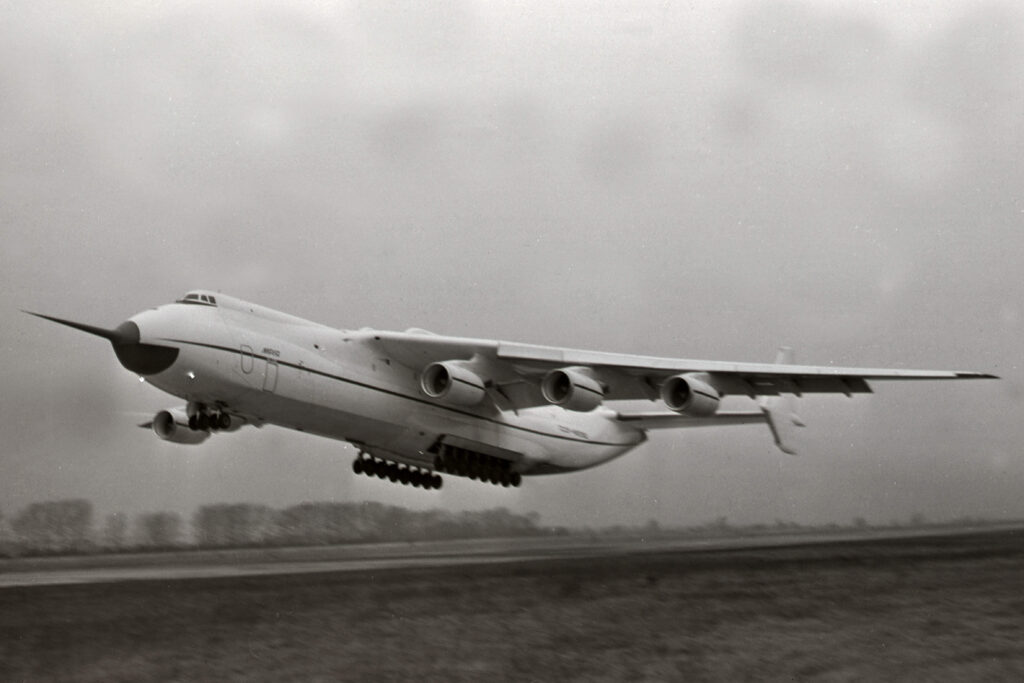The article first appeared on AeroTime on December 21, 2019.
At one point in time, it was the largest commercial aircraft in the world. On this day, the Antonov An-255 took off for the first time on December 21, 1988. The Antonov Design Bureau, now known only as Antonov, engineered and built the aircraft during the late 1980s to help the Soviet space program. It transported the Buran shuttle orbiter and components of the Energiya carrier rocket and was designed to also be used as a flying space launching site in the reusable aerospace transport system (MAKS).
Unfortunately, the aircraft was destroyed while it was on the ground in Kyiv, Ukraine, in February 2022, as Russia launched a full-scale invasion of Ukraine.
On a snowy and breezy evening in Svyatoshyn, Kyiv, Ukraine, Mriya (Dream in Ukrainian) took off on its maiden journey from Antonov’s own airport, currently named Kyiv Hostomel Airport (GML). The first test flight was the result of four years’ worth of work, according to the operator of the aircraft, Antonov Airlines. The first flight was handled by seven crew members:
The flight captain, Oleksandr Galunenko, first officer Sergii Gorbik, navigator Sergii Nechayev, senior flight engineer Oleksandr Shuleshchenko, flight engineer Volodymyr Gusar, radio operator Vyacheslav Belousov and leading test flight engineer Mykhaylo Kharchenko.
Based on the smaller quad-engine An-124, the “universal super-heavy transport aircraft” was stretched by 50 feet (15 meters) and its’ wingspan was increased by the same amount. Two extra Progress D-18T engines were also added. The list of changes also included the aircraft’s tail: from a single vertical stabilizer to a twin tail with a swept-back horizontal stabilizer, enabling the aircraft to carry the Buran or any other external cargo without disrupting the flow of air around the back of the Mriya.
Compared to the An-124, the An-225 can also carry a much bigger payload – 551,155 lbs. (250,000 kilograms) versus the payload of the smaller transport aircraft of 330,693 lbs. (150,000 kilograms).
In total, the Antonov An-225 carried the Buran for 28 hours and 27 minutes on 14 different flights across the Soviet Union. As the Iron Curtain crumbled and multiple republics declared independence, the Soviet space program also crumbled with it, making the Mriya obsolete for almost a decade. But due to the demand for transportation of heavier cargo than the An-124 can handle, in 2000, Antonov began the restoration of the An-255 to an airworthy condition.
In May 2001, it received its Airworthiness Certificate and completed its first commercial flight since the restoration in January 2002, hauling food supplies for United States troops stationed in the Persian Gulf from Germany. The An-225, now registered as UR-82060, last flew from Guam International Airport (GUM) to U-Tapao International Airport (UTP) in Thailand in September 2018, marking over a year since it was last seen in the air. Antonov spokesperson confirmed the information, adding that the Mriya is under maintenance since November 2018.
However, we are more than likely to see the six-engine beast take off once again, as Antonov extended the An-225’s service life until at least 2033.
“Specialists of ANTONOV Company developed staged extension of calendar service life, which stipulates inspection of the aircraft and its systems each two years. Owing to this, it is not necessary to perform overhaul and stop the aircraft operation for a long period,” commented the manufacturer’s spokesperson to AeroTime regarding the extension of the service life of the Mriya at the time.
Now, the Ukrainian aviation company is beginning to work on the second frame of the An-225. It estimated that the cost to rebuild it would be as much as €500 million ($530 million).
While global air freight tonnage is on a downward spiral, as air freight tonnage is at the lowest point in the past three years, according to International Air Transport Association (IATA) data as of December 2019, this should not impact An-225’s operations, since the six-engine aircraft “is used for transportation of oversized and superheavy cargoes. Each transport mission of AN-225 is unique. So, these factors will not impact on AN-225 operation,” noted Antonov’s representative.
Environmental issues, namely noise and gas emissions, are also being addressed, as the operator of the biggest aircraft would have fit the An-225 with new engines, the D-18 series IIIM, confirmed the company’s spokesperson at the time.
